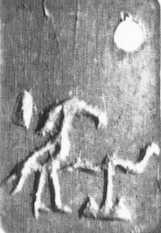In 1989, Gunter Dreyer discovered in a tomb at Abydos, 300 miles south of Cairo, ivory or bone tablets some 5,400 years old,
that reveal one of the oldest known stage of the hieroglyphic writing. Those small plates, about three centimeters squared, were probably used as labels to show the origin and content of boxes and containers. Among more than 200 pieces, one represents, apparently, a Northern Bald Ibis.
 |
| Akh, about -3400 |
Since then, a crested ibis has represented the hieroglyph
Akh, having probably an phonetic correlation between the bird and the concept.
 |
| Representing Akh besides a solar disk is very common |
The Akh is one of the five constituents of the human personality which becomes eternal and unchanged in the Death Realm.
Akh also means "to be resplendent, to shine", wich could be related to the glossy Northern Bald Ibis feathers.
 |
| Another Akh in a sunk-relief |
The coloured versions of the
Akh seem to diverge from the natural colour pattern. This is probably due to the fact of a progressive decline of Northern Bald Ibis. The material and pictorial evidence dealing with the northern bald ibis is much more accurate, precise, and elaborate in the early periods of Egyptian history (until the end of the 3rd millennium BC) while, in later times, the representations become more and more schematized, showing probably that the artists were no familiar to the bird in the late phase because ok the extinction of the species in Egypt.
More information about Northern Bald Ibis in Egypt is available on this interesting work by Jiří Janák.




No comments:
Post a Comment